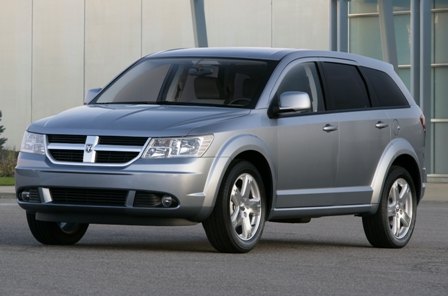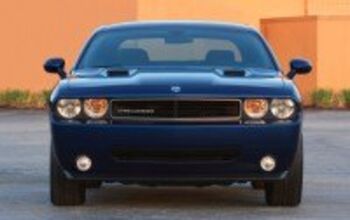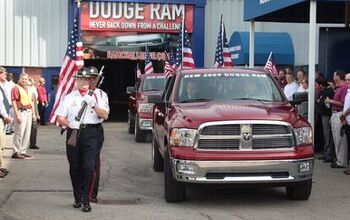2009 Dodge Journey Review
Back in 2004, Chrysler thought it had a segment-busting winner with the Pacifica. Neither car, minivan, nor SUV, the luxurious large “crossover” was supposed to play a key role in Chrysler’s planned move upscale. Buyers lined-up none deep for Chrysler’s bloated station wagon. The automaker was forced to de-content, discount and discontinue the disastrous distraction. Stunned by the Pacfica-shaped sales sinkhole, it took Chrysler another five years to field another three-row crossover. The 2009 Dodge Journey is in many ways the anti-Pacifica. Will it be any more successful?
With its chiseled lines and pillbox-on-wheels proportions, people noticed the Pacifica (even if most didn’t like what they saw). In comparison, the Journey’s boxy—but not boxy enough to make a statement—exterior is totally, completely, utterly forgettable. Even with flared fenders, the Journey has no curb appeal whatsoever. In fact, the Journey’s so unrelentingly bland that it manages to appear much smaller than it actually is.
The Pacifica’s Mercedes-lite interior was the most upscale to ever grace a modern Chrysler. You’ll find no such luxury cues inside the new Dodge Journey (fake chrome highlights don’t count). Yes, there’s a bit of style, with a high-contrast color scheme and a few artfully curving surfaces. And the instrument panel upper is finger sink soft. But all the bits attached to it, including the protruding center stack, are straight from the bargain basement. It looks, feels and smells cheap.
Chastened by the Pacifica’s failure, Chrysler prioritized function over form. Innovative storage compartments fill every nook and cranny of the Journey’s cabin: under the front passenger seat, under the floor in the second row, under the cargo floor, inside the doors, pretty much everywhere you look. For larger cargo, every seat save the driver’s folds flat.
But budget cutting must have ravaged the human factors department; the driving position is an ergonomic abomination. The steering wheel rim obstructs the temperature gauge and the right half of the tach, and the optional rearview monitor is positioned at knee level. Get the nav, though, and the screen moves to the top of the center stack; apparently the legal department remains intact.
Consistent with the current ChryCo style, the seats could not be more lacking in contour. The second-row split bench (Captains need not apply) bi-folds to clear a narrow path to the third row. Unfortunately, third row accommodations are tighter than . . . well, you know what I mean. If any soul should dare trespass thereabouts, arguments are guaranteed. The second row is only roomy enough for adults when ratcheted all the way back—which eliminates any (as in any) third row leg room.
The Dodge Journey is offered with your choice of two powerplants: a 173-horse 2.4-liter four hitched to a four-speed automatic or a 235-horse 3.5-liter V6 connected to a six-speed slushbox. (Only the latter is available with all-wheel drive.) Motorvating two tons of crossover, the Journey’s V6 provides sufficient acceleration but few thrills- unless you’re turned on by mild torque steer. The 4.0-liter powerplant from the minivans would have made things more interesting, but that doesn’t seem to be the theme here.
That said, you can order the Dodge Journey with a (woo-hoo!) performance suspension and 19-inch alloys. Our test Journey had the touring suspension and 17s. Thus shod, the Journey feels very much like a 7/8-scale minivan. The amount of body lean is acceptable for a three-row family-hauler, and the chassis is sufficiently poised to keep the driver out of trouble.
Not that the driver will seek trouble. The somewhat heavy steering feels exceptionally numb. And speaking of Novocain, the Journey’s driving experience is the only aspect of the vehicle that’s more forgettable than the exterior styling. The upside: bumps and other road imperfections are nicely absorbed. The performance suspension won’t fix the steering, but it could well deprive the Journey of this single dynamic strength.
And then there’s quality control . . .
The V6 tester had a quarter-inch of water in the front passenger floorboard (promptly extracted via shop vac). The source was soon revealed, as a gurgle could periodically be heard from the perimeter of the sunroof and water rained down from the overhead console throughout the test drive. Get this: it wasn’t raining outside the car at the time; it had rained the previous day.
The Dodge Journey is everything the Pacifica was not; it’s forgettable, functional and designed to sell for a low price. But Chrysler has failed to realize that today’s CUV buyers aren’t looking for one thing or the other. They don’t want form at the expense of function or function at the expense of form. They want both, AND comfort AND reliability. Plenty of other crossovers deliver all four. The Dodge Journey is destined to be no more visible in the sales charts than it is on the road.
Michael Karesh lives in West Bloomfield, Michigan, with his wife and three children. In 2003 he received a Ph.D. from the University of Chicago. While in Chicago he worked at the National Opinion Research Center, a leader in the field of survey research. For his doctoral thesis, he spent a year-and-a-half inside an automaker studying how and how well it understood consumers when developing new products. While pursuing the degree he taught consumer behavior and product development at Oakland University. Since 1999, he has contributed auto reviews to Epinions, where he is currently one of two people in charge of the autos section. Since earning the degree he has continued to care for his children (school, gymnastics, tae-kwan-do...) and write reviews for Epinions and, more recently, The Truth About Cars while developing TrueDelta, a vehicle reliability and price comparison site.
More by Michael Karesh
Latest Car Reviews
Read moreLatest Product Reviews
Read moreRecent Comments
- Analoggrotto I don't see a red car here, how blazing stupid are you people?
- Redapple2 Love the wheels
- Redapple2 Good luck to them. They used to make great cars. 510. 240Z, Sentra SE-R. Maxima. Frontier.
- Joe65688619 Under Ghosn they went through the same short-term bottom-line thinking that GM did in the 80s/90s, and they have not recovered say, to their heyday in the 50s and 60s in terms of market share and innovation. Poor design decisions (a CVT in their front-wheel drive "4-Door Sports Car", model overlap in a poorly performing segment (they never needed the Altima AND the Maxima...what they needed was one vehicle with different drivetrain, including hybrid, to compete with the Accord/Camry, and decontenting their vehicles: My 2012 QX56 (I know, not a Nissan, but the same holds for the Armada) had power rear windows in the cargo area that could vent, a glass hatch on the back door that could be opened separate from the whole liftgate (in such a tall vehicle, kinda essential if you have it in a garage and want to load the trunk without having to open the garage door to make room for the lift gate), a nice driver's side folding armrest, and a few other quality-of-life details absent from my 2018 QX80. In a competitive market this attention to detai is can be the differentiator that sell cars. Now they are caught in the middle of the market, competing more with Hyundai and Kia and selling discounted vehicles near the same price points, but losing money on them. They invested also invested a lot in niche platforms. The Leaf was one of the first full EVs, but never really evolved. They misjudged the market - luxury EVs are selling, small budget models not so much. Variable compression engines offering little in terms of real-world power or tech, let a lot of complexity that is leading to higher failure rates. Aside from the Z and GT-R (low volume models), not much forced induction (whether your a fan or not, look at what Honda did with the CR-V and Acura RDX - same chassis, slap a turbo on it, make it nicer inside, and now you can sell it as a semi-premium brand with higher markup). That said, I do believe they retain the technical and engineering capability to do far better. About time management realized they need to make smarter investments and understand their markets better.
- Kwik_Shift_Pro4X Off-road fluff on vehicles that should not be off road needs to die.






































Comments
Join the conversation
I have had my 2009 Dodge Journey for three years now and I have 72,000 kms. on it. I find it the best vehicle I have ever owned. The only serious problem I had was I had to get my brakes shoes and rotors renewed and I subsequently got my money back from Chrysler for the work was considered too premature for the age of the vehicle. I have the V6 235 HP engine and get around 22 mpg Canadian gallons. If I drive speed limits, I get much better mileage. The only complaints I would have with the interior are the seats could look better and the coffee holders are a bit low for me. It has lots of storage area, drives quiet, and passes anything on the road when I want to pass. I would recommend anyone buying a new vehicle to take a good look at the 2011 journey with the new Pentastar V6 engine. It offers 50 more HP with slightly better mileage.
It's rather funny how wrong all these nay sayers were and are. The Jouney has not only become the number one selling Cross Over here in Canada. Better yet has been the Top pick by the IIHS for safety. The all new 2011 Journey is an amazing upgrade with the all new soft touch panels, to the amazing standard features including touch screen audio and climate controls. With all this being said... If your looking for the best vehicle at the best price. Trust me, stop by at your local Chrsyler Dodge Jeep dealers and have a good look for yourself. For all those who made silly conclusions, you too should take a better look of what this vehicle has become. Trust me when I say this.. "this is the best over all Utility vehicle you will ever buy"